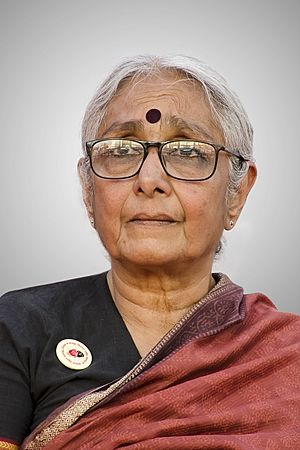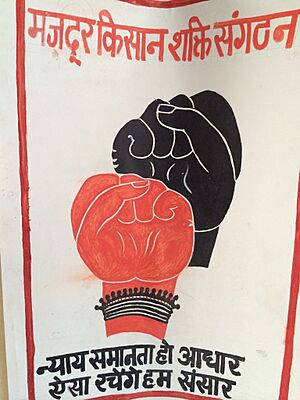Aruna Roy facts for kids
Quick facts for kids
Aruna Roy
|
|
|---|---|
 |
|
| President of the National Federation of Indian Women | |
| In office 2008–2024 |
|
| Preceded by | Dr. K. Saradamoni |
| Succeeded by | Syeda Saiyidain Hameed |
| Personal details | |
| Born | 26 May 1946 Madras, British Raj |
| Nationality | Indian |
| Spouse | |
| Alma mater | Indraprastha College (B.A.) Delhi University (M.A.) National Academy of Administration (M.P.Adm.) |
| Occupation | Activist, professor, union organiser and civil servant |
| Awards | Ramon Magsaysay Award, 2000 Lal Bahadur Shastri National Award, 2010 |
Aruna Roy (born May 26, 1946) is an Indian social activist, a former professor, and a union organizer. She used to be a government officer in the IAS. She was the president of the National Federation of Indian Women and helped start the Mazdoor Kisan Shakti Sangathan.
Contents
Aruna Roy's Early Life
Aruna Roy was born on June 6, 1946, in Chennai, Tamil Nadu, India. At that time, Chennai was called Madras. Her parents were Hema and E. D. Jayaram. Her family was quite unique for their time. They believed in helping everyone and treated all people equally.
Her grandparents were well-educated. Her grandmother was a kind woman who volunteered to help poor communities. Her grandfather was an engineer who wrote textbooks for poor children. Aruna's mother, Hema, was very smart. She was good at science, math, and languages.
Aruna's parents got married even though they came from different backgrounds. Her father, Jayaram, was also involved in social and political work. He helped with India's fight for independence. Later, he became a government worker.
Her Education Journey
Aruna was the oldest of four children. Her family taught them to speak three languages: Tamil, English, and Hindi. They were encouraged to think for themselves and treat everyone with respect, no matter their background.
Aruna learned Bharatanatyam (a classical Indian dance) and Carnatic music. She also went to a convent school and learned French. Later, she studied at the Aurobindo Ashram in Pondicherry. After that, she moved to New Delhi and finished her schooling.
She then went to Indraprastha College for Women and studied English Literature. In 1965, she earned her master's degree from the University of Delhi.
Becoming a Civil Servant
After college, Aruna didn't want to just be a homemaker. She wanted to work and make a difference. In 1967, when she was 21, she took a very difficult exam for the Indian Administrative Service (IAS). This was a government job that was hard to get, especially for women. Aruna passed on her first try! She was one of only 10 women to qualify that year.
She believed that joining the IAS was a way to work for social justice. She was inspired by Mahatma Gandhi and his ideas about helping people. She spent two years training for her new role.
Working for the Government
From 1968 to 1974, Aruna worked as a civil servant. Her first job was in Tiruchi district in Tamil Nadu. Later, she moved to Vellore district. In 1970, she married Sanjit Roy, who was also involved in social work. She changed her name to Aruna Roy.
She then moved to Delhi and worked as a Sub-Divisional Magistrate. She handled many duties, including student protests and elections. Later, she became the Deputy Secretary for finance.
However, Aruna became unhappy with her government job. She had joined to help people and bring about change. But she felt that the system was too old-fashioned and didn't help the poor enough. She saw corruption and felt it was hard to make real changes from inside the system. She realized that honest officers often couldn't speak up.
She decided that the government system wasn't moving in the right direction. She felt it was not possible to bring change from within. So, she decided to leave the civil services.
Life at Barefoot College
In 1974, Aruna took a break from her job to join her husband at the Social Work Research Centre. This place was also known as the Barefoot College. She saw how her husband worked equally with everyone there, unlike the formal way she was treated as a government officer.
Later that year, she left her government job. She was 28 years old. She moved to Tilonia, a small village in Rajasthan, where her husband had started the Barefoot College in 1972. The college aimed to help the village develop socially and economically.
Life in Tilonia was very different for Aruna. There was no running water or electricity. She had to walk long distances. Aruna had grown up in cities and didn't know much about village life. She lived with other college employees, sharing all the duties, from cooking to setting up schools for children. The Barefoot College also brought new technologies like solar power to villages.
At first, it was hard for Aruna to be accepted by the villagers. But she welcomed this, as she was no longer seen as an authority figure but as an equal. She believed that people should be in charge of their own change. An old woman named Dhani Bhua helped her get used to village life. Aruna started spending time with the women, giving advice on different issues.
Aruna learned a lot from the villagers. She realized that even people who couldn't read or write had deep knowledge about their work. She felt that Tilonia was her real "alma mater" (a place where you learned a lot).
Moving Towards Collective Action
The Barefoot College helped villages become self-sufficient. But Aruna started to wonder if they were making a big enough difference. She wanted to encourage people to work together and demand their rights.
In 1981, she met Naurti Bai, a woman who led a strike of 500 workers demanding fair wages. Aruna learned how powerful information could be in helping people organize. The Barefoot College even took a case to court about unpaid wages. In 1983, the court ruled in favor of the workers. That same year, Aruna decided to leave Barefoot College to find new ways to help people in rural India.
Years of Organizing
From 1983 to 1987, Aruna worked with different groups in Rajasthan. She wanted to encourage people to take collective action. In 1985, she helped organize a "mahila mela" (women's festival) in Rajasthan. This was a big event focused on poor rural women's rights. Thousands of women attended. It was the first time in that area that people publicly discussed violence against women.
In 1987, Aruna and other activists, Shankar Singh and Nikhil Dey, moved to Devdungri village. They wanted to build a new organization there. They lived in a simple mud and stone hut, just like the villagers. This helped them understand the challenges people faced.
It was hard for Aruna to gain the trust of the villagers at first. They saw her as an outsider. But she worked hard to be transparent and honest. She spent time with the women, sharing their problems and helping them. She encouraged them to speak up and take part in protests, especially against violence.
In 1988, Aruna and her team helped villagers in Sohangarh get back 25 hectares of land that a landlord had taken. This success showed the villagers how powerful working together could be.
Later, they helped workers who weren't getting their full wages for famine relief work. They organized protests and got media attention. Even though the results weren't perfect, the team realized they needed a stronger organization to fight for people's rights.
Mazdoor Kisan Shakti Sangathan
On May 1, 1990, the Mazdoor Kisan Shakti Sangathan (MKSS), which means "Workers' and Peasants' Power Collective," was officially started. Aruna Roy, Nikhil Dey, and Shankar Singh were the main leaders.
The MKSS was created to help poor people in rural areas fight for their rights. It was not a traditional political party or a formal union. It had no official leader and made decisions together. The group did not accept money from governments or big companies. They relied on volunteers and supporters.
The MKSS started by fighting for fair wages for workers. This work eventually led to a bigger movement for the Right to Information in India.
Right to Information Movement
Aruna Roy became a key leader in the movement for the Right to Information (RTI) in India. Through the MKSS and another group called the National Campaign for People's Right to Information (NCPRI), she worked tirelessly. Their efforts led to the passing of the Right to Information Act in 2005. This law allows ordinary citizens to ask for information from the government, making things more transparent.
Aruna Roy's Continued Work
Aruna Roy has continued to champion the rights of poor and marginalized people. She has been involved in campaigns for:
- The Right to Information
- The Right to Work (which led to the NREGA, a law guaranteeing jobs in rural areas)
- The Right to Food
More recently, she has worked for universal pensions for workers who are not in organized jobs. She is also involved in campaigns for laws that protect whistleblowers (people who report wrongdoing) and help citizens get their complaints addressed by the government.
Aruna Roy was a member of the National Advisory Council (NAC) until 2006. In 2018, she and the MKSS group published a book called The RTI Story: Power to the People. This book tells the story of the Right to Information movement in India.
Awards and Recognition
Aruna Roy has received many honors for her important work:
- In 1991, she received the Times Fellowships Award for her work with rural workers.
- In 2000, she was given the prestigious Ramon Magsaysay Award for Community Leadership.
- In 2010, she received the Lal Bahadur Shastri National Award.
- In 2011, Time magazine named her one of the hundred most influential people in the world.
- In 2017, Times of India listed her as one of 11 Human Rights Activists whose mission is to help others live with dignity.
- In December 2024, Aruna Roy was included on the BBC's 100 Women list.


